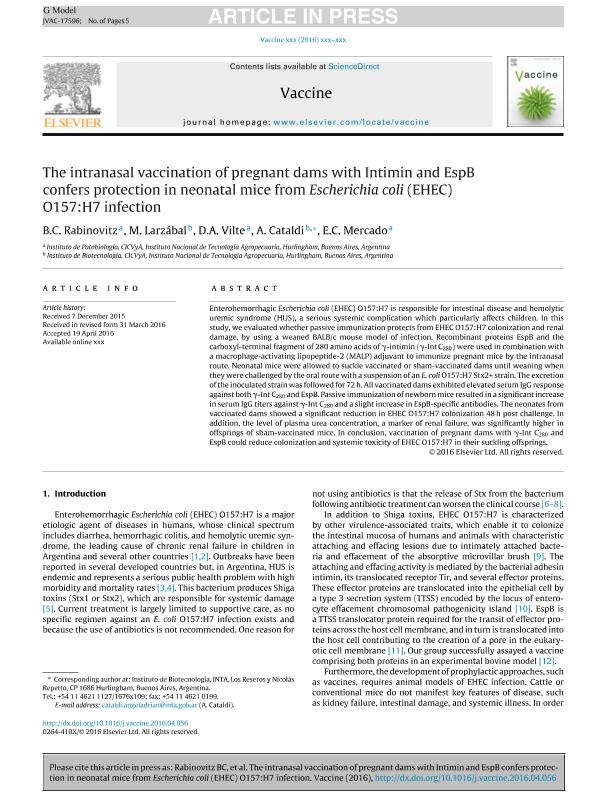Artículo
The intranasal vaccination of pregnant dams with Intimin and EspB confers protection in neonatal mice from Escherichia coli (EHEC) O157: H7 infection
Rabinovitz, Bettina Carol ; Larzabal, Mariano
; Larzabal, Mariano ; Vilte, Daniel Alejandro; Cataldi, Ángel Adrián
; Vilte, Daniel Alejandro; Cataldi, Ángel Adrián ; Mercado, Elsa Cristina
; Mercado, Elsa Cristina
 ; Larzabal, Mariano
; Larzabal, Mariano ; Vilte, Daniel Alejandro; Cataldi, Ángel Adrián
; Vilte, Daniel Alejandro; Cataldi, Ángel Adrián ; Mercado, Elsa Cristina
; Mercado, Elsa Cristina
Fecha de publicación:
05/2016
Editorial:
Elsevier
Revista:
Vaccine
ISSN:
0264-410X
Idioma:
Inglés
Tipo de recurso:
Artículo publicado
Clasificación temática:
Resumen
Enterohemorrhagic Escherichia coli (EHEC) O157:H7 is responsible for intestinal disease and hemolytic uremic syndrome (HUS), a serious systemic complication which particularly affects children. In this study, we evaluated whether passive immunization protects from EHEC O157:H7 colonization and renal damage, by using a weaned BALB/c mouse model of infection. Recombinant proteins EspB and the carboxyl-terminal fragment of 280 amino acids of -intimin (-Int C280) were used in combination with a macrophage-activating lipopeptide-2 (MALP) adjuvant to immunize pregnant mice by the intranasal route. Neonatal mice were allowed to suckle vaccinated or sham-vaccinated dams until weaning when they were challenged by the oral route with a suspension of an E. coli O157:H7 Stx2+ strain. The excretion ofthe inoculated strain was followed for 72 h. All vaccinated dams exhibited elevated serum IgG response against both -Int C280 and EspB. Passive immunization of newborn mice resulted in a significantincrease in serum IgG titers against -Int C280 and a slight increase in EspB-specific antibodies. The neonates from vaccinated dams showed a significant reduction in EHEC O157:H7 colonization 48 h post challenge. In addition, the level of plasma urea concentration, a marker of renal failure, was significantly higher in offsprings of sham-vaccinated mice. In conclusion, vaccination of pregnant dams with -Int C280 and EspB could reduce colonization and systemic toxicity of EHEC O157:H7 in their suckling offsprings.
Archivos asociados
Licencia
Identificadores
Colecciones
Articulos(SEDE CENTRAL)
Articulos de SEDE CENTRAL
Articulos de SEDE CENTRAL
Citación
Rabinovitz, Bettina Carol; Larzabal, Mariano; Vilte, Daniel Alejandro; Cataldi, Ángel Adrián; Mercado, Elsa Cristina; The intranasal vaccination of pregnant dams with Intimin and EspB confers protection in neonatal mice from Escherichia coli (EHEC) O157: H7 infection; Elsevier; Vaccine; 34; 25; 5-2016; 2793-2797
Compartir
Altmétricas



